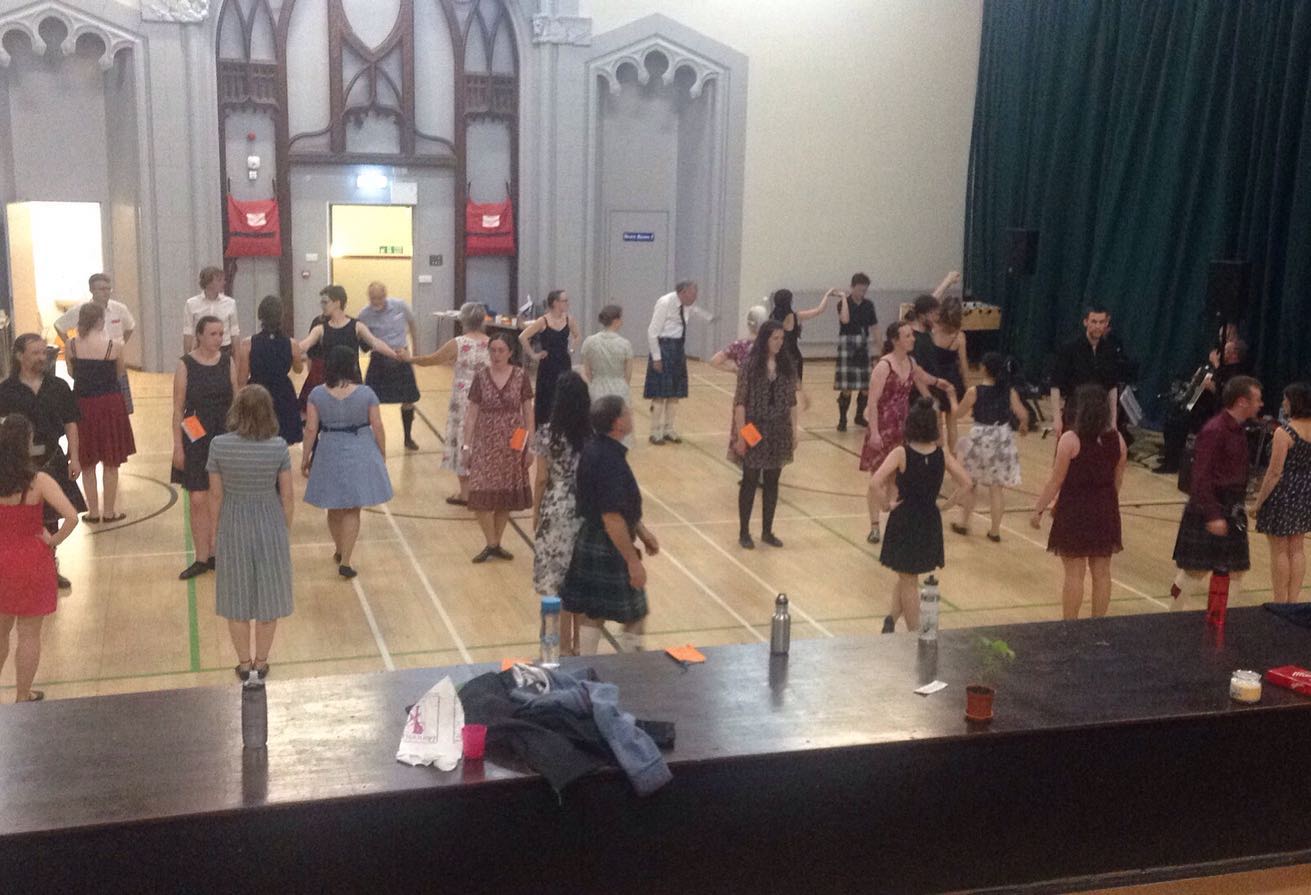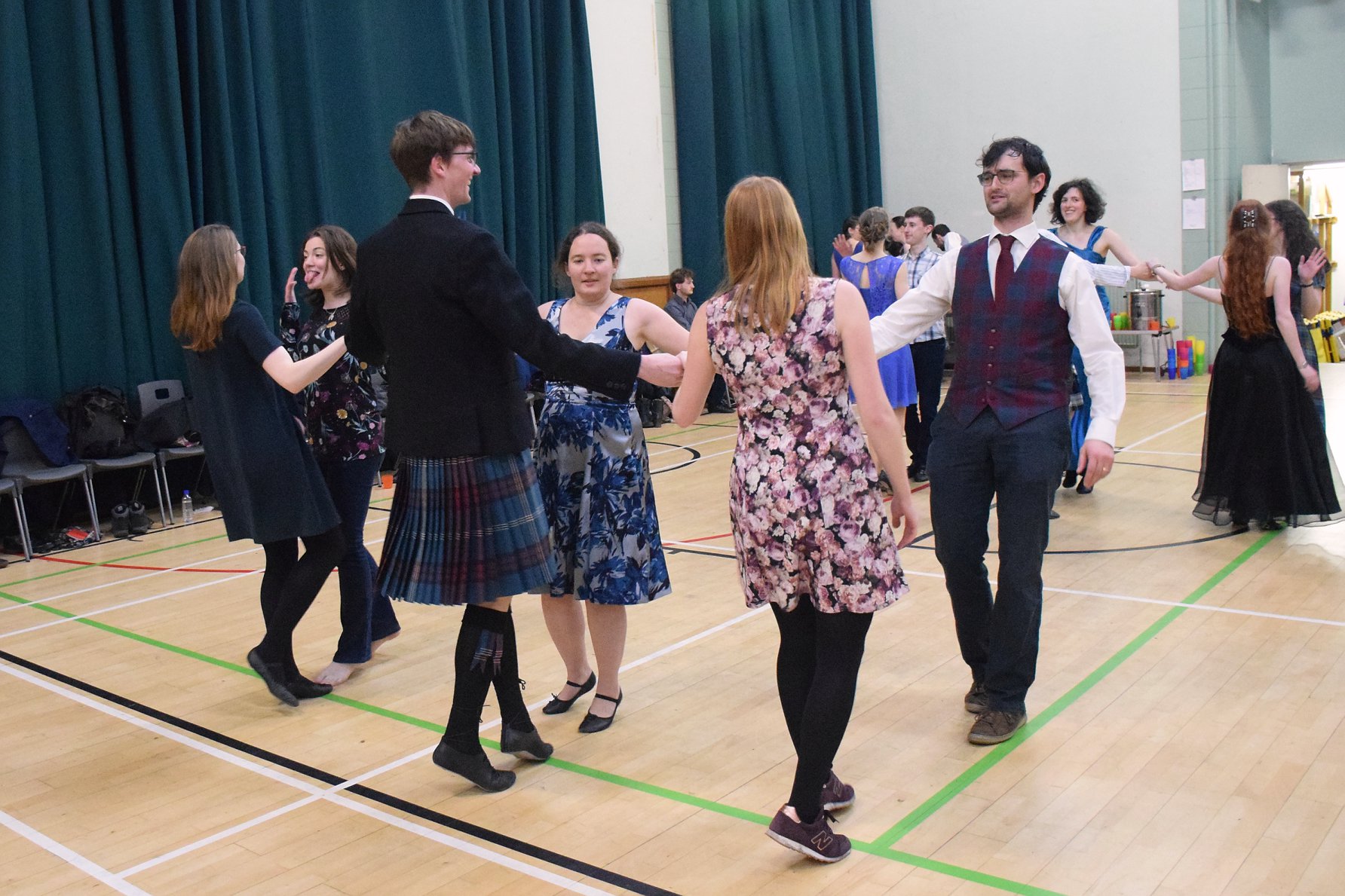Introduction
If you have ever been to a ceilidh then you will almost certianly have danced several simple Scottish country dances. These are the dances danced in ‘sets’ – whether ‘square sets’ where you stand next to your partner forming one side of a square or ‘long-wise’ sets where you stand opposite you partner in a line of similarly positioned couples.
Tempo and Music
There are two tempos in Scottish country dancing. There are fast reels (2/4 or 4/4 time), jigs (6/8 time) and hornpipes (2/4 or 4/4 time), such as those danced at ceilidhs; and there are slow, elegant Strathspeys (2/4 or 4/4 time) – a dance form unique to Scotland. Some dances are medleys – part of the dance is in Strathspey time and part(s) in reel and/or jig time.
Although any reel (or hornpipe!) can be danced to any reel tune and any jig to any jig tune etc., each dance actually has a specific ‘signature’ tune or tunes which are associated with it. The music, or at least the name, of the tune or tunes will be published along with the dance. However, as almost all tunes are too short for the appropriate dance to be dances to completion (and repetition of the same music numerous times is not very exciting!), the signature tune is often only played at the beginning and end of the dance, with the musicians picking other appropriate tunes for the middle sections. E.g. if a dance is danced eight times through (see Formations – the make-up of the dance) then the signature tune will usually be played during the first and eighth times through the dance.

Sets – how you ‘form up’ for the dance
All Scottish country dancing is danced in sets. These may be ‘long-wise’ sets where you stand opposite your partner, and the man has his left shoulder towards the top of the set (= band/music) so that there is a line of men and a line of women. Longwise sets are frequently made up of 4 couples but may contain 3, 5 or 7 couples.
Alternativley the set may be ‘square’ in which case you stand beside you partner (woman on the man’s right), forming one side of the square with 3 other couples forming the other 3 sides. A ‘three couple square set’ is effectivley a ‘triangular set’. In five and six couple square sets the 5th and 6th couples are in the middle of the set and the dance description will explain how they should start the dance.
Another type of set is that for a ’round the room dance’ where your ‘half set’ progresses one way round the room, dancing with each ‘half set’ progressing the other way in turn. Such ‘half sets’ may be composed, for example, of a couple, two couples or 3 people.

Formations – the make-up of the dance
Each Scottish country dance is made up of a sequence of formations (for example ‘circle round and back’, ‘advance and retire’, ‘turn corner, partner, corner, partner’ or ‘pousette’ – some are obviously more self-explanatory than others!).
Each formation is allocated a particular phrase of the music and the duration of the dance (once through) is determined by the number of formations contained in it. To be danced once through, the majority of dances require 32 bars (although 40 bar dances are not uncommon) and most dances are repeated until every couple has had one or two turns of being ‘top’ or ‘dancing’ couple – 4 or 8 times, for example, in a 4 couple set.
There are of course many exceptions to this – some dances are danced once through only (and may be 96, 128 or more bars long!). In these dances every couple usually does an equal amount of dancing. Such dances may be made up of a number of ‘sections’ – for example a ‘beginning and end section’ on either side of a ‘middle section’ or a ‘chorus’ which is repeated interspersed with ‘verses’. Some, however, have no such ‘logic’ and remembering a sequence of formations lasting 96 bars or more can be a severe memory test!

Learning Scottish country dancing
When learning Scottish country dancing it is important to realise that no one actually knows all the dances – there are after all an estimated 9,000 of them! The trick is to know the formations (for example, what is a ‘pousette’ or an ‘allemand’, how do I dance a ‘reel of four’ and who is my ‘first corner’?) and then learn the dance just before you dance it – this may be by reading the ‘crib’ (dance instructions) usually obtained with your ticket at a Scottish dance, or by listening carefully to the ‘caller’ who is telling you how to do the dance, or describing it as you walk it though. If none of these are helping try asking someone in your set and if it turns out none of you know how to do the dance try looking at the set next to you! You will eventually find that you do remember the dances you do most often (there are always ‘old favourites’ which lots of people know) but do not worry if this takes time.
New Scotland’s Beginners Country Dance class takes just this approach. Each week you’ll learn new figures and dance them in increasingly more difficult dances; but you are not expected to remember each dance from one week to the next – just how to do the figures! Everyone is welcome at our Beginners class even if you’ve never done dancing of any type before. For more experienced Scottish country dancers we also run an Intermediate Country Dance class and a Demonstration class weekly.

‘Reeling’
Reeling is the same type of dancing as Scottish Country Dancing, in that ‘reelers’ dance the same dances as Scottish country dancers; but it is a different style of dancing the dances (popular for example within the army). Therefore if you are a Scottish country dancer and you attend a ‘Reelers Ball’, or you are a reeler and you attend a Scottish country dance, you should not find the differences too confusing.
However, reelers will probably not be familiar with such a large repetoire of dances as Scottish country dancers, and country dancers should be aware that there are variations in the way some dances are danced at reeling events. For example it may be worth checking on how to do a Reel of the 51st Division ‘Aberdonian style’ and how to ‘double’ the Duke of Perth! (Useful ‘Hints on Reeling’ may be found in the Appendix of ‘Collins Scottish Country Dancing’.)
History of Scottish Country Dancing
In Scotland, country dances were probably first danced in the early eighteenth century and in its earliest form country dancing involved a selection of dances danced in ‘long-wise’ sets. The country dance had become fashionable in England over a hundred years earlier in the reign of Queen Elizabeth I, but in the eighteenth century the popularity of this form of dancing increased greatly and it spread to several European countries. The term “country dancing” comes from the court term ‘Contredanse’ to describe a dance where you faced your partner.
During the 17th and 18th centuries, country dancing became popular throughout Britain, and many collections of dances were published. The dances were performed in the polite “assembly rooms” or ballrooms of the 18th century, including those in Edinburgh and Glasgow, and young ladies and gentlemen attended dancing schools to learn them. As time went on, the dances spread to the towns and villages as well, blending with the social dancing of the Scottish people (Robert Burns attended a dancing school in Ayr).
Although the country dances danced in Scotland were essentially part of an international repertoire, during the eighteenth century dances began to emerge which had distinctive Scottish characteristics. Some dances were referred to as ‘Scotch dances’ and many were danced to tunes with Scottish titles, which then passed on to become the names of the dances. In Scotland in the eighteenth century, another type of dance – the threesome and foursome reels (where three or four dancers alternated dancing reels with individual setting steps) – was also popular, and these influenced the form of many Scottish country dances. Probably Scotland’s most notable contribution to the tradition of country dancing, however, is the Strathspey. This slow style of dance with its characteristic ‘dotted’ rhythm is uniquely Scottish, and emerged in Scotland around the middle of the eighteenth century.
During the 19th century, other new dance fashions from the Continent, such as the waltz and the quadrille, gradually eclipsed country dancing in England. However, country dances remained popular in Scotland with elements of the new dance forms being incorporated. Thus the ‘Waltz country dance’ appeared and the traditional quadrille ‘square set’ formation which can be found in country dances such as the ever popular ‘Eightsome Reel’.
A tradition of country dancing in the Scottish regiments may have helped the continued popularity of these dances in Scotland and the fact that the dances appealed to all sections of the population. However, after the First World War dances inspired by ragtime syncopated rhythms began to oust country dancing from Scottish ballrooms, and by the early 1920’s only a handful of Scottish country dances were still being danced.
Enter, in 1923, the Scottish Country Dance Society (later “Royal”) led by Jean Milligan of Glasgow. Determined to revive the traditional dancing before it faded away completely, the SCDS organized classes, standardized the steps, and began publishing books of the surviving dances as well as those preserved in earlier books and manuscripts.
The past 75 years have seen Scottish Country Dancing not only come back to life, but develop and grow as a living tradition. In Scotland the huge popularity of ceilidhs means that large numbers of people are able to enjoy fun and simple country dances and ceilidh dances, while Reelers balls and Scottish country dances (which might collectively be defined as ‘Scottish balls’) are also popular all over the country. Elsewhere, Scottish emigrants took the dancing with them to countries like Canada, New Zealand, and the US and other Scottish dance enthusiasts are to be found in Scottish Country Dance societies all over Europe and indeed almost anywhere in the world.
Many new dances have been devised in recent years, often adding new variants to the traditional patterns, and a typical dance programme consists of a combination of old and new. It is estimated that about 9,000 published dances exist altogether.
